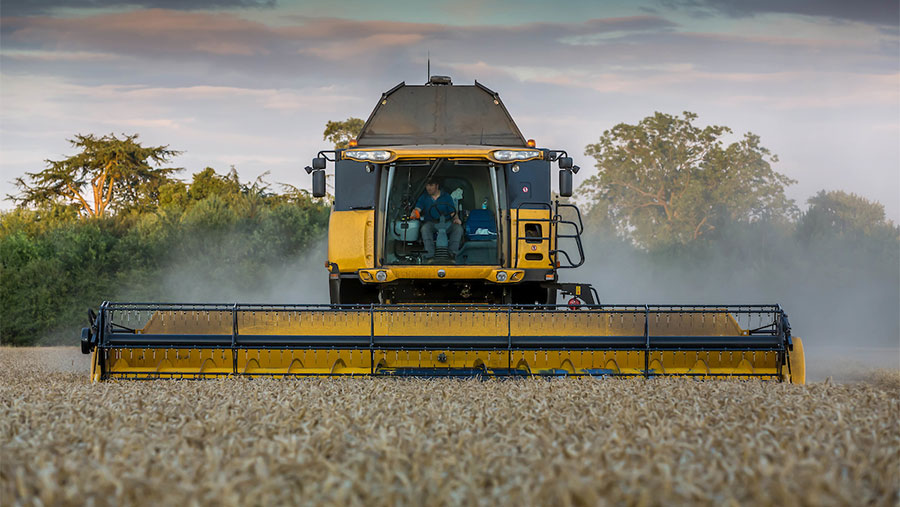Harvest 2021: Cereal yields hold up, but quality is slipping
 © Tim Scrivener
© Tim Scrivener Cereal growers are pushing on with harvest where and when they can, and yields sit close to five-year averages – but quality is slipping as standing crops are exposed to unfavourable conditions.
Dorset
George Hosford has as little as two days left of harvest at Travellers Rest Farm, near Blandford Forum, as long as the weather holds out.
“We’ve combined all the cereals and have just the beans and poppies left once we’ve finished sowing cover crops,” he said.
His 100ha of Maris Otter winter malting barley averaged a pleasing 5t/ha with acceptable specific weights and good quality.
Oilseed rape was an overall success. “We averaged 3t/ha over 100ha – yields are not what they were five years ago, but we grew it cheaply and the current price is strong,” he added.
Over the August bank holiday weekend, Mr Hosford finished cutting his Gleam, Extase and Costello winter wheats. They averaged 14-16% moisture and gave yields of 9.7t/ha at specific weight 76kg/hl, 9.5t/ha at 78kg/hl, and 9.25t/ha at 80kg/hl, respectively.
The 65ha of Laureate spring malting barley caused the combine driver a little stress. “It all went rather flat. It made it a slow job, but quality didn’t suffer and the grain made specification. It averaged 7.5t/ha with a good specific weight and about 1.7% nitrogen,” he said.
Wiltshire
Moving further north, this year’s August has been the worst Tim Carson can remember at Alton Barnes, near Devizes, with little sunshine and 100mm of rain.
“I have about three or four days of harvest left to do. While we still might have had quantity, we saw a lot of the quality washed away,” he said.
His 243ha of winter wheats – Crusoe, Extase, and Skyfall – were significantly hit by the weather, consigning them to the feed market.
“Yields averaged between 9t/ha and 10t/ha, and while proteins were good at 13.5%, Hagbergs were virtually non-existent and the specific weights were very low.”
Mr Carson isn’t optimistic about his 40.5ha of Mascani winter oats either, with a late disease challenge becoming apparent as the combine entered the field.
Hertfordshire
Further east, most of Charles Martin’s cereals have gone through the combine at Mill House Farm, Bedmond – but harvest has not been smooth sailing.
His Mascani winter oats yielded a disappointing 5t/ha at about 16% moisture, but the 57ha of Group 2 winter wheat Siskin was acceptable at 6-7.5t/ha.
“I’ve had nothing back from sampling yet, but it’s quite a robust variety and it only required one dose of fungicide.”
Some 12ha of Laureate spring barley was drilled after failed winter wheat, and its yield averaged 5t/ha at 16% moisture.
Mr Martin’s 31ha of Tundra winter beans should be combined next week if storage is available. “It’s been a bit of a shambles with the beans; despite treating them accordingly for weeds, we had poppies coming up in the crop.”
Durham
Michael Manners has finished cereal harvest at Coniscliffe Grange Farm, near Darlington, with high praise for his conventional six-row winter barley variety Funky.
“The 40.5ha averaged 9.8t/ha at 67kg/hl. It’s very easy to grow; I don’t know why more people don’t grow it,” he said.
Next to see the combine was his 324ha of winter wheats, consisting of varieties Gleam, Parkin, Siskin and Grafton. Gleam and Parkin averaged a pleasing 9.9t/ha, with crops following beans pushing up to 11.8t/ha.
But late septoria in the Siskin has Mr Manners concerned about the variety. “Despite managing and treating the crop as well as it should be, we still had an issue and that worries me – we won’t be growing it again,” he added.
Specific weights across the wheats averaged 76kg/hl, while moistures were high at 18-20%.
Last of the combinable crops is 30ha of Tundra winter beans and 61ha of Vertigo spring beans.
“The winter beans looked fantastic until they were hit by high winds about four weeks ago. We should go in on them on Tuesday; we won’t be going into the spring beans for at least another two weeks,” he said.

